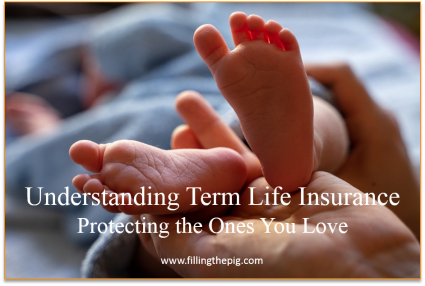I still remember my first experience with term life insurance. It was when I started my first “real” job out of college working for a large corporation. During the new employee orientation period, term life insurance was offered as one of the enrollment options for my health care benefits. Back then I didn’t know what term life insurance was, or how it could benefit me. As far as I was concerned, my life was pretty simple. I really didn’t have anything of value that needed to be insured. From my perspective term life insurance was an unnecessary expense.
Fast forward, five years later.
Then came marriage, family, a house, two vehicles a cat and a dog named Jake. I had finally reached a point in my life where what I had to lose and the ones I loved were too important not to protect. And that’s when term life insurance entered the picture.
Life insurance can be a pretty complex topic of discussion. In general, there are two different types of life insurance. Term life insurance and permanent life insurance. And in between, there are a number of different options.
If you have been considering a life insurance policy to protect the ones you love. And make sure they are taken care of should you meet some unfortunate fate. Term life insurance may be a simple solution for you. This article focuses on the basics of term life insurance and answers the simple question. What is term life insurance?
What is Term Life Insurance? A Definition
Term life insurance is the simplest and most inexpensive form of life insurance. Term life insurance serves one purpose. To pay a death benefit (money) if you die. Term life insurance is sometimes called pure life insurance.
Term life insurance is purchased for a specific period of time. Hence the word term.
Once the period of a term policy expires, the policyholder can renew for another term. Convert the policy to another permanent life insurance policy like whole life or universal life, or allow the policy to terminate. No benefits are paid after the policy ends.
Term life insurance is most often purchased as a means of survivor protection. A means of replacing the income of a deceased spouse/parent to assure the remaining family members are able to maintain a certain quality of life.
How Term Life Insurance Works?
There are four primary components that make up a term life insurance policy.
- Term: The period of time you purchase the life insurance policy. Common term lengths are one, five, 10, 20 or 25 years. Term life insurance may also be purchased for a predetermined age. For example, you may purchase a policy that ends at the age of 60 or 65.
- Premium: This is how much you will pay for the life insurance policy. Premiums are based on your age, the term of the policy, the face value of the policy, your health and life expectancy. Common payment terms are monthly, quarterly, semi-annually or annually. Annual premiums are the lowest.
- Face Value (death benefit): This is how much the policy will pay if you die. The higher the face value the higher the premium.
- Beneficiary: This is the individual or entity that will receive the death benefit should you die. In most cases, the beneficiary is a spouse, significant other, or children. The beneficiary could also be an estate, trust, charity or college/university.
Options Available with a Term Life Policy
Similar to all life insurance policies, pure life policies allow you to customize the policy to meet your needs. The option you select may increase or decrease the premium you pay.
Some of the more common pure life policy options are:
- Level Term: This is the most common term life policy. The premiums and the face value stay the same throughout the term of the policy.
- Decreasing Term: This scenario keeps the premium level (the same) while the face value decreases throughout the term of the policy. This option is common when a policy is purchased to pay off a loan. Over the years the policies face value decreases from year to year as the loan value decreases.
- Increasing Term: This option increases the face value and the premium over the term of the policy. The goal is to compensate for the cost of living adjustments as expenses rise.
Additional policy options include:
- Renewability: With any life insurance policy an individual’s health and age will impact the premiums paid. As one gets older the likely hood of death increases. Insurance companies use health exams as a means of determining an individual’s insurability. The renewability option allows an existing policyholder to forgo future medical exams to renew a policy.
- Convertibility: This option allows a pure life insurance policyholder to convert their policy to another permanent life policy. For example: convert a term life policy into a whole or universal life policy without proof of insurability. As long as the term policy has not expired.
- Return of Premium: This option returns all of the premiums paid to the policy owner should they live until the end of the policy term.
All of these policy options will impact the premium paid for the policy.
Related Posts:
- 10 Successful Money Management Tips to Live By – from a 52-Year-Old
- The Art of Being a Cheapskate – How I Successfully Manage My Budget
- Do You Have Self-Limiting Beliefs about Money? Getting Out of Debt
- How Surviving Wisconsin Winters is Like Managing Your Money
How Much Insurance do You Need?
Everyone’s situation is different. Considering the “what ifs” when someone dies isn’t always an easy process. However, it is important to protect those things that are most important to you. Term life insurance is most often purchased to protect an individuals loved ones.
In general, there are two ways to determine how much money your policy should provide.
- Future Income: This method focuses on the income level of the “breadwinner” of a household. The assumption is if the primary income earner dies, the lost future earnings of that provider need to be replaced.
- For example: If Nancy is the primary income earner for her family of four, and makes $50,000 per year. She may want to provide a benefit for her family for 10 years. In this case, the face value of the policy, based on her current income level would be $500,000. ($50,000 x 10 years)
- Needs Approach: This method focuses on the current and future expenses that would need to be covered should a spouse or loved one die. The face value of the policy is based on adding all future expenses up. Expenses that may be considered are:
- Living expenses for the surviving spouse and children. The future earning potential of a surviving spouse. And the time period until a minor turns 18 or 21.
- Mortgage or car loans – any debt that my create hardship due to the loss of a primary income earner.
- College tuition. The face value of a policy could be used to fund a child’s education.
- Burial costs: proceeds from the death benefit could be used to cover expenses associated with the death of the policy owner.
- Estate creation: Most individuals will spend their whole life building a portfolio of assets from their income. A home, investments, savings accounts and other personal items of value. If you die prematurely you never have the opportunity to build an estate. Term life insurance via the proceeds allows you to create an estate upon your death.
There are no definitive rules to define how much coverage should be purchased with a term life insurance policy. For some policy owners, they may only want to cover the expenses associated with their death. For others, it will be the long-term well fair of their family.
Where to Buy Term Life Insurance?
As discussed earlier, term life insurance is one of the most popular forms of life insurance. The good news is access to an assortment of providers makes the purchase of term life insurance easily accessible. The not so good news is that there are so many different providers it can become confusing as to which provider to choose.
Two options for purchasing a pure life policy.
- Group Life Insurance Policy: The most common form of group insurance is to purchase a policy through your employer. Some employers as a benefit to their employees will purchase a group life insurance policy. Group policies allow employees to participate in term coverage as long as they are employed. Employees can select their policy coverage options, choose their beneficiaries and change the value of their policies while employed. Employees receive a certificate of insurance as proof of coverage through the group policy. In most cases purchasing term life insurance through a group policy will be less expensive than purchasing an individual policy. In addition, employer-sponsored policies rarely require proof of insurability.
- Individual Policy: If your employer does not provide a group policy option, individuals can purchase term life insurance on their own. Many home and auto insurance companies like State Farm and American Family provide term life insurance solutions. In addition, be sure to check out companies like Northwest Mutual, Liberty Mutual or Prudential which specialize in life insurance.
When shopping for an individual policy be sure you understand the insurability requirements of the policy. And how those requirements may change over time. In addition, understand the convertibility options. Should you decide to convert your pure life policy to a permanent policy in the future.
Protecting the One’s You Love
When we are younger we rarely consider the impact our death may have on the ones we love. Our own self-preservation is more important than the responsibilities we have for someone else. And in most cases our time horizon is short-term.
However, as we take on the responsibilities of career, a spouse, and children our responsibilities tend to grow exponentially. And with all that responsibility comes the realization, that our death may leave the ones we love in financial hardship.
At the time of this writing. The average cost of a $250,000 term life policy for a 30-year-old female was @$16.00 per month. A 30-year-old male with the same policy would pay about $19 per month. (nerdwallet 2019)
When you consider the monthly cost of a term policy with the protection you receive. It’s easy to understand why term policies are so common.
Consider term life insurance a security blanket for the ones you love. A means of providing a safety net should the unfortunate happen.
Helpful Resources:
- Average Term Life Insurance Rates for 2019 – nerdwallet
- Insurance for Dummies – Available at Amazon
- Liberty Mutual Insurance – Home, Auto, Life
Do you have a term life insurance policy? How did you determine how much coverage you needed? Comment below.



